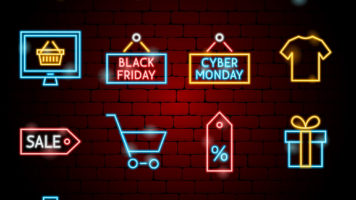Amazon Prime Day: First Thoughts
Amazon’s fifth annual high-impact Prime Day event formally launched today, July 15th, with news-hype worthy of the massive event it has become. It’s billed as a quick, intensive two-day affair, but that’s misleading. Our tracking of this year’s Amazon’s Prime Day themed emails shows messaging promoting “Early Prime Day deals” first deploying as early as July 1st, Amazon having previously revealed dates for the main event on June 22nd. July 1st was also when Amazon announced its July 10th “Prime Day Concert,” starring Taylor Swift among others, streamed live on Amazon Prime Video. We also know from previous years that some Prime Day discounting will continue for several days after the formal event “ends.”
In our previous Prime Day deep-dives, we’ve focused on how Amazon has used email to support Prime Day; that is, what campaigns they deployed, when, and with what success. That’s always been quite impressive and it has been again, so far, this year. During their 22-day Prime Day run-up, Amazon:
- Deployed almost 800 Prime Day-themed email campaigns worldwide, with a total projected circulation quantity of 760 million.
- Drove 24% average read rates.
Those are robust numbers for sure, but they’re also what we’ve come to expect from Amazon.
So this year, we’re focusing more on Amazon’s major retail competitors, for whom Prime Day understandably poses a serious challenge. They can’t ignore Prime Day, but it’s hard to counter — never mind avoid mentioning — a huge competitor’s strongly branded blockbuster event, especially when its timing is usually a closely guarded secret until very close to the event itself.
But this year, things changed a bit. Amazon’s June 22nd announcement of its 2019 Prime Day dates occurred twenty-two days in advance of the event itself (versus fourteen and twelve days, respectively in 2018 and 2017). That’s still not a lot of lead-time in which to plan and mount a major retail promotion, but it’s adequate leeway if you already know — from four years of previous experience — the week in which Prime Day will almost certainly occur.
The larger point is that Amazon’s major competitors cannot — and most do not — ignore Prime Day. One of the biggest aspects of the Amazon threat shows up in what we call “email subscriber overlap,” the extent to which two brands share an email audience. We can see subscriber overlap as part of what we track from the large consumer panel supporting our Competitive Tracker data platform. The fact is, Amazon’s email audience is so enormous that it creates powerful overlaps with virtually every major retail brand (and many others in most consumer-based industries).
Take a look at this graph below. It shows, for fifteen major multi-channel retail brands, the percent of Amazon overlap within each of their email audiences. Within the group, the average Amazon overlap is 59%. That is, 59% of their email audiences are also receiving Amazon’s email.

Look also at this graph below, which shows Amazon overlap for eighteen major specialty and/or online retail brands. The average Amazon overlap In this group is 58%, and one is almost 70%.

Taken together, there’s a powerful story here. Not only is Amazon a formidable competitor in every product and service category they occupy. They’re also —due to their best-in-class audience and message optimization — formidable competitors for attention and engagement in their customers’ email inboxes.
So, we went looking for how Amazon’s retail competitors have attempted to cope with this year’s Prime Day, and how they’ve deployed related email. Some have, and some haven’t. For at least Macy’s and Dick’s Sporting Goods, countervailing events appear to have been timed to began and end just before Prime Day.
Here are examples of what we saw from these brands in the two days before Prime Day. As we’ve observed in the past, read rates for these campaigns generally underperform those of Amazon’s comparably timed Prime Day emails.
- Major Multichannel Brands
- Bed Bath and Beyond: “Summer Black Friday Deals”
- Dick’s Sporting Goods: “20% off Ends Tonight”
- CVS: “Hot deals at your CVS Pharmacy.”
- Kohl’s: “Announcing doorbuster deals.”
- Walmart: “Biggest savings of the season.”
- Office Depot: “Swing of summer sale.”
- Macy’s: “Ends Tonight! Don’t miss Black Friday in July.”
- Target: “Sale on Summer Faves”
- Specialty/Online Brands
- DSW: “Clearance Event!”
- eBay: “Prime deals!”
- Wayfair: Multiple messages with subject lines variously referencing, “CLOSEOUT,” “Deals” and “Major Markdowns.”
- Overstock: “Summer Savings”
- GAP: “Deals on deals”
- Modell’s: “25% Off”
- Overstock: “Warm weather deals! Summer savings won’t last.”
- Shoe Carnival: “FLASH Sale Extravaganza!”
- Children’s Place: “60% Off Entire Site!”
Why does this matter? Amazon is a “perfect storm” of email best practice. It’s hard for Amazon’s competitors to counter a promotional event with the heft and momentum of Prime Day. But because of Amazon’s powerful email subscriber overlap with other retail brands, it’s still important to observe and understand how Amazon uses email to support the Prime Day event, in terms of serving up well-timed, highly relevant content. Amazon applies those practices year-round, and they’re critical to the success with which Amazon has engaged and retained their customers. In a future Blogpost, we will take a closer look at Amazon’s execution of email best practice.







